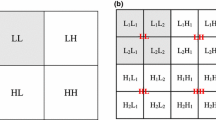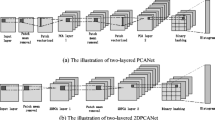Abstract
This study, for the first time, developed an adaptive neural networks (NNs) formulation for the two-dimensional principal component analysis (2DPCA), whose space complexity is far lower than that of its statistical version. Unlike the NNs formulation of principal component analysis (PCA, i.e., 1DPCA), the solution with lower iteration in nature aims to directly deal with original image matrices. We also put forward the consistence in the conceptions of ‘eigenfaces’ or ‘eigengaits’ in both 1DPCA and 2DPCA neural networks. To evaluate the performance of the proposed NN, the experiments were carried out on AR face database and on 64 × 64 pixels gait energy images on CASIA(B) gait database. The less reconstruction error was exploited using the proposed NN in the condition of a large sample set compared to adaptive estimation of learning algorithms for NNs of PCA. On the contrary, if the sample set was small, the proposed NN could achieve a higher residue error than PCA NNs. The amount of calculation for the proposed NN here could be smaller than that for the PCA NNs on the feature extraction of the same image matrix, which represented an efficient solution to the problem of training images directly. On face and gait recognition tasks, a simple nearest neighbor classifier test indicated a particular benefit of the neural network developed here which serves as an efficient alternative to conventional PCA NNs.
















Similar content being viewed by others
References
Yang J, Zhang D, Alejandro FF, Yang J (2004) Two-dimensional PCA: a new approach to appearance-based face representation and recognition. IEEE Trans Pattern Anal Mach Intell 26(1):131–137
Wang L, Wang X, Feng J (2006) On image matrix based feature extraction algorithms. IEEE Trans Syst Man Cybern B Cybern 36:194–197
Ren CX, Dai DQ (2010) Incremental learning of bidirectional principal components for face recognition. Pattern Recogn 43(10):318–330
Ben X, Wang K, Yan R, POPOOLA Oluwatoyin Pius (2011) Subpattern-based complete two dimensional principal component analysis for gait recognition. Proc Chin Assoc Sci Technol 7(2):16–22
Xu A, Jin X, Jiang Y (2006) Complete Two-Dimensional PCA for Face Recognition. In: 18th International conference on pattern recognition, Hong Kong, China, vol 3, pp 481–484
Zhang D, Zhou Z (2005) (2D)2PCA: two-directional two-dimensional PCA for efficient face representation and recognition. Neurocomputing 69:224–231
Ye J (2004) Generalized low rank approximation of matrices. In: 21st International conference on machine learning, pp 887–894
Liu J, Chen S (2006) Non-iterative generalized low rank approximation of matrices. Pattern Recogn Lett 27:1002–1008
Lu C, Liu W, An S (2008) A simplified GLRAM algorithm for face recognition. Neurocomputing 72:212–217
Kima YG, Songa YJ, Changa UD, Kimb DW, Yunc TS, Ahna JH (2008) Face recognition using a fusion method based on bidirectional 2DPCA. Appl Math Comput 205:601–607
Yang J, Liu C (2007) Horizontal and vertical 2DPCA-based discriminant analysis for face verification on a large-scale database. IEEE Trans Inf Forensics Secur 2:781–792
Baldi PF, Hornik K (1995) Learning in linear neural networks: a survey. IEEE Trans Neural Netw 6:837–858
Diamantaras KI, Kung SY (1996) Principal component neural networks: theory and applications. In: Adaptive and learning systems for signal processing, communications, and control, Wiley, New York
Oja E (1982) A simplified neuron model as a principal component analyzer. J Math Biol 15:267–273
Oja E, Karhunen J (1985) On stochastic approximation of eigenvectors and eigenvalues of the expectation of a random matrix. J Math Anal Appl 104:69–84
Lv JC, Zhang Y, Li YX (2015) Non-divergence of stochastic discrete time algorithms for PCA neural networks. IEEE Trans Neural Netw Learn Syst 26(2):394–399
Sanger TD (1989) Optimal unsupervised learning in a single-layer linear feedforward neural network. Neural Netw 2:459–473
Oja E (1992) Principal components, minor components and linear neural networks. Neural Netw 5:927–935
Kung SY, Diamantaras KI, Taur JS (1994) Adaptive principal component extraction and applications. IEEE Trans Signal Process 42:1202–1217
Haykin S (1994) Neural networks—a comprehensive foundation. Macmillan, New York
Andreas W, Kurt H (2000) Local PCA Algorithms. IEEE Trans Neural Netw 11(6):1242–1250
Kong XY, An QS, Ma HG et al (2012) Convergence analysis of deterministic discrete time system of a unified self-stabilizing algorithm for PCA and MCA. Neural Netw 36:64–72
Karhunen J, Oja E, Wang L, Vigario R, Joutsensalo J (1997) A class of neural networks for independent component analysis. IEEE Trans Neural Netw 8(3):486–504
Gou S, Jiao L (2005) Image recognition using Synergetic Neural Network. Lect Notes Comput Sci 3497(2):286–291
Chen S (1995) Nonlinear time series modeling and prediction using Gaussian RBF networks with enhanced clustering and RLS learning. Electron Lett 31:117–118
Tomenko Vladimir (2011) Online dimensionality reduction using competitive learning and Radial Basis Function network. Neural Netw 24(5):501–511
Eric CT, James CB, Nikhil RP (1994) Fuzzy Kohonen clustering networks. Pattern Recogn 27(5):757–764
Ceylan R, Ozbay Y (2007) Comparison of FCM, PCA and WT techniques for classification ECG arrhythmias using artificial neural network. Expert Syst Appl 33(2):286–295
Huang W, Oh SK, Pedrycz W (2014) Design of hybrid radial basis function neural networks (HRBFNNs) realized with the aid of hybridization of fuzzy clustering method (FCM) and polynomial neural networks (PNNs). Neural Netw 60:166–181
Alexandridis Antonios K, Zapranis Achilleas D (2013) Wavelet neural networks: a practical guide. Neural Netw 42:1–27
Zhang F, Du B, Zhang LP (2015) Saliency-guided unsupervised feature learning for scene classification. IEEE Trans Geosci Remote Sens 53(4):2175–2184
Carvajal Gonzalo, Figueroa Miguel (2014) Model, analysis, and evaluation of the effects of analog VLSI arithmetic on linear subspace-based image recognition. Neural Netw 55:72–82
Bian W, Tao D (2011) Max-min distance analysis by using sequential SDP relaxation for dimension reduction. IEEE Trans Pattern Anal Mach Intell 33(5):1037–1050
Yang WK, Wang ZY, Sun CY (2015) A collaborative representation based projections method for feature extraction. Pattern Recogn 48(1):20–27
Yang WK, Sun CY, Zhang L (2011) A multi-manifold discriminant analysis method for image feature extraction. Pattern Recogn 44(8):1649–1657
Sun M, Zhao L, Cao W, Xu Y, Dai X, Wang X (2010) Novel hysteretic noisy chaotic neural network for broadcast scheduling problems in packet radio networks. IEEE Trans Neural Netw 21(9):1422–1433
Chen W, Jiao L, Li J, Li R (2010) Adaptive NN backstepping output-feedback control for stochastic nonlinear strict-feedback systems with time-varying delays. IEEE Trans Syst Man Cybern B Cybern 40(3):939–950
Chang C, Juang J (2008) An adaptive multipath mitigation filter for GNSS applications. EURASIP J Adv Signal Process. http://portal.acm.org/citation.cfm?id=137.6536.1387861
Gross R (2005) Face databases. In: Jain AK, Li SZ (eds) Handbook of face recognition, vol 1. Springer, New York, p 22
Yu S, Tan D, Tan T (2006) A framework for evaluating the effect of view angle, clothing and carrying condition on gait recognition. In: Proceedings of 18th international conference on pattern recognition, Hong Kong, China, pp 441–444
Ben X, Meng W, Yan R (2012) Dual-ellipse fitting approach for robust gait periodicity detection. Neurocomputing 79:173–178
Acknowledgments
The authors would like to thank Dr. T. Tan from the National Laboratory of Pattern Recognition (NLPR), Institute of Automation, Chinese Academy of Sciences, for providing us with the CASIA(B) gait database. This project is supported by the Natural Science Foundation of China (Grant No. 61201370), the Specialized Research Fund for the Doctoral Program of Higher Education of China (Grant No. 20120131120030), the Independent Innovation Foundation for Postdoctoral Scientists of Shandong Province (Grant No. 201303100), the National Science Foundation for Postdoctoral Scientists of China (Grant No. 2013M530321), the Special Program of China Postdoctoral Science Foundation (Grant No. 2014T70636) and the Key Laboratory of Intelligent Perception and Systems for High-Dimensional Information, Ministry of Education (Grant No. 30920140122006). The authors thank the reviewers, Prof. Jian Yang from Nanjing University of Science and Technology, Prof. Yanfeng Gu and Prof. Jiafeng Liu from Harbin Institute of Technology, Prof. Wankou Yang from Southeast University and Prof. Chuanxian Ren from Sun Yat-Sen University for their useful suggestions.
Author information
Authors and Affiliations
Corresponding author
Appendix
Appendix
Here, we provide a proof of Eq. (29).
The statistical average of \( \varvec{s}(t + 1) \) can be written as
Therefore,
Rights and permissions
About this article
Cite this article
Ben, X., Meng, W., Wang, K. et al. An adaptive neural networks formulation for the two-dimensional principal component analysis. Neural Comput & Applic 27, 1245–1261 (2016). https://doi.org/10.1007/s00521-015-1922-z
Received:
Accepted:
Published:
Issue Date:
DOI: https://doi.org/10.1007/s00521-015-1922-z




